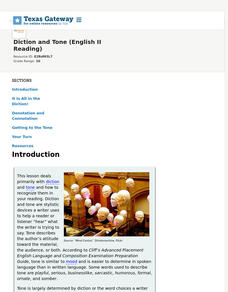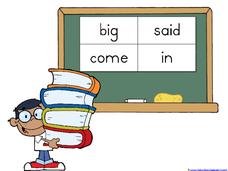Curated OER
Dolch First Grade Word Cards
Forty-one sight word cards are presented in this seven-page packet of worksheets. The words are in alphabetical order, and are among the highest-used words in our language.
Bearsden Academy's English Blog
Close Reading Homework Booklet
Wind turbines, daylight savings time, noise pollution, social problems. To develop close reading skills, high schoolers examine pairs of articles presenting opposing viewpoints of the same topics and respond to questions that require not...
Curated OER
Express Yourself Lesson Seed 6 Close Reading
Look back at the third chapter of The Cay with your class. Pupils will conduct a close reading, taking a second look at a chunk of text and responding to a series of text-dependent questions. Wrap up with an analytical writing prompt...
University of North Carolina
Reading Aloud
Warning: reading your paper aloud may cause bystanders to think you're talking to yourself. However, as the 14th installment of 24 in the Writing the Paper series from UNC explains, it is one of the best strategies for revision. Through...
Florida Center for Reading Research
Fluency: Letter-Sound Correspondence, Make a Match
A memory activity engages young learners in letter-sound correspondence. Pairs take turns examining two sets of cards lying face down. They flip one image card and one letter card, then name the initial sound. If the sounds match, pupils...
Curated OER
Shizuko’s Daughter: List-Group-Label Strategy
Help your learners navigate the vocabulary of Shizuko's Daughter by Kyoko Mori with a lesson on categorizing words. After coming up with a list of things that grow from the earth, learners decide which categories each words belong in.
Curated OER
Word Roots 5: NAT, TRACT, SEQU Advanced Puzzle 1, 2, & 3
Break down the connection between word roots and words with similar meanings with this resource. Learners use a list of words, a brief definition of each word, and twelve word roots with blanks next to them to fill in. They then fill in...
Curated OER
Word Roots 5: NAT, TRACT, SEQU Intermediate Puzzle 1, 2, & 3
Build vocabulary with this resource. This online activity breaks up a list of words into words that have common roots. Learners are given the definition of each word as well as the word root and are asked to fill in the rest of the...
Curated OER
Come Fly with Me . . . Open a Book: Travels through Literature
This detailed overview of a curriculum unit suggests using travel literature to engage and stimulate your third graders’ interest in reading. The suggested reading list includes fiction and non-fiction materials and offers urban children...
Novelinks
The Color of Water: Word Square Instructions
Immaculate, accumulation, dissipation. Vocabulary drawn from chapter 16 of James McBride's memoir, The Color of Water, can prove to be challenge for readers. To help kids understand the meaning of these words and what they add to the...
EngageNY
Research Tasks: New Words, Relevant Information, Revision
Word builders. Scholars participate in a mini lesson about affixes. They then complete a research vocabulary organizer and share their definitions of the words with the class. They gather more evidence for their research from the...
EngageNY
Reading for Gist, Answering Text-Dependent Questions, and Determining Author’s Purpose: Industrial Organic Food Chain
After re-reading The Omnivore’s Dilemma using a Reading Closely: Guiding Questions handout, class members use sticky notes to annotate and determine the gist of the text. Finally, they use an Author’s Purpose graphic organizer to...
Texas Education Agency (TEA)
Diction and Tone (English II Reading)
Words carry baggage. In addition to their literal, denotative meaning, words also carry the weight of the associations and connotations attached to the word—the connotations of words writers use to create the tone of a piece. An...
EngageNY
Getting the Gist and Determining Word Meaning: Paragraphs 20–23 of Steve Jobs’ Commencement Address (and connecting to Chapter 10)
Groups create a list of the character traits of Steve Jobs and Buddy, the main character of Christopher Paul Curtis' Bud, Not Buddy, and share and select evidence from Jobs' 2005 Stanford University Commencement Address to support their...
EngageNY
Vocabulary Strategies and Questions from the Text: Close Reading Part 2 of The Lightning Thief (Chapter 3, Continued)
That is very unexpected! Scholars take a close look at the word unexpectedly from chapter three of The Lightning Thief. They examine the prefix and think of other words that have the same prefix. Learners regroup in their triads and take...
EngageNY
Reading to Determine Important Relationships between People and Events: The Importance of the 1936 Olympics for African Americans (Promises to Keep, Pages 16–19)
Scholars look at cause-and-effect relationships while doing a close read of the 1936 Olympics on pages 16-19 of Promises to Keep. They complete a cause-and-effect note catcher and add their ideas to an anchor chart. Readers then work...
EngageNY
Reading for Details: Taking an Inventory in the Rainforest (Pages 28–31)
Take inventory. Scholars analyze pages 28-31 of The Most Beautiful Roof in the World and use a note catcher to model how Meg Lowman took inventory of the species in the rainforest. Learners then take a close look at the vocabulary in the...
Curated OER
Words Worksheet
In this words worksheet, learners fill in the missing words to sentences, make endings for sentences, read lists of words, and more. Students complete 5 activities.
Novelinks
Nightjohn: List-Group-Label Strategy
Encourage readers of Nightjohn, Gary Paulsen's young adult novel about slavery set shortly before the Civil War, to develop their categorization and organizational skills with a strategy that asks them to list all the words they can...
Syracuse City School District
Greek and Latin Roots, Prefixes, and Suffixes
How can adding a prefix or suffix to a root word create an entirely new word? Study a packet of resources that focuses on Greek and Latin roots, as well as different prefixes and suffixes that learners can use for easy reference.
1 plus 1 plus 1 equals 1
I Can Read! Sight Words Set #6
Master the sight words big, said, come, and in with a packet of helpful reading activities. Kids work on their reading skills with tracing pages and bingo activities, as well as flash cards, connect-the-dots, and a short word search.
1 plus 1 plus 1 equals 1
I Can Read! Sight Words Set #1
Focus on the fundamentals of reading with a series of sight word activities. Kids work with the words a, and, see, and the by connecting the dots, playing bingo, and finding the words in a mixed-up list.
1 plus 1 plus 1 equals 1
I Can Read! Sight Words Set #18
Identify four sight words with an extensive reading packet. After kids learn the words under, new, was, and be, they work on tracing and finding the words in fun new ways.
Curated OER
Sentences for Sight Word Dictation
Improve your learners' reading and writing skills with a set of sentences designed to help pupils work with sight words. The teacher dictates while the pupils write; this is followed by discussion.

























